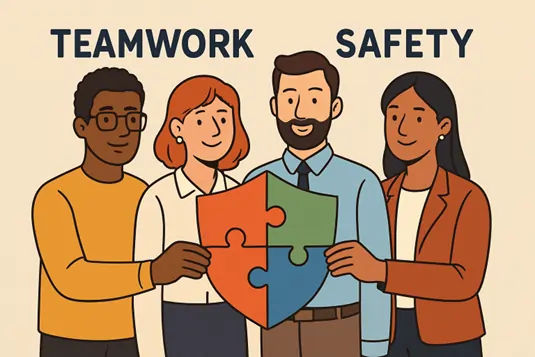Proactive Strategies For Preventing Workplace Violence Today
Why Employers Must Address Workplace Violence Now
Addressing workplace violence can no longer be considered optional for employers today. From news headlines to firsthand accounts, the presence and risks of violence in professional environments have become a prominent threat that no industry can afford to ignore. National data illustrate the magnitude of the issue: According to the Occupational Safety and Health Administration (OSHA), nearly two million workers in the United States report being victims of workplace violence every year.
Developing strategies to create safer, more secure workplaces is essential to protect employees and organizations. Early safety investments support compliance and risk mitigation, employee well-being, and overall productivity. One of the most effective first steps is to get workplace violence prevention training for your team. High-quality training programs help employees recognize warning signs and empower them with knowledge to take safe, preventive action before a situation escalates. Such initiatives also foster a culture of vigilance and shared responsibility across the organization. When employees feel confident in their ability to respond, workplace trust and morale improve. Over time, this proactive approach strengthens both individual resilience and organizational stability.
Types Of Workplace Violence: More Than Physical Threats
Physical altercations aren’t the only forms of workplace violence. Threats, harassment, intimidation, bullying, and even subtle forms of aggression, such as exclusion or humiliation, contribute to an unsafe environment. Left unchecked, these behaviors wear down morale, erode trust, and can develop into physical confrontations or chronic stress disorders. It’s essential to recognize that workplace violence is any act in which an employee is abused, threatened, intimidated, or assaulted in their employment.
Maintaining a comprehensive workplace safety policy means addressing both visible and invisible threats. Fostering an environment where non-physical behaviors are addressed with the same seriousness as physical altercations is crucial to prevention.
Warning Signs Employees Should Watch For
- Sudden and dramatic changes in personality, behavior, or mood
- Frequent absenteeism, tardiness, or withdrawal from workplace interactions
- Increasing conflicts, arguments, or hostile exchanges with colleagues
- Direct threats, intimidating language, or aggressive gestures
- Notable drops in productivity and declining interest in work tasks
Managers and employees who understand these early warning indicators are well-positioned to intervene proactively. Routine check-ins, wellness conversations, and open-door policies encourage reporting concerns before they escalate.
Building A Culture Of Respect And Safety
Promoting a culture rooted in respect, psychological safety, and inclusivity forms the backbone of violence prevention. Organizations that champion transparent communication, empathy in daily interactions, and clear expectations for behavior are more likely to deter negative behaviors. Empowering employees to speak up without fear of retaliation is critical in fostering a safe and accepting work environment.
Formal policies alone aren’t enough. Everyday actions shape safety culture—how managers support their teams, how conflicts are handled, and how quickly concerns are addressed. External resources, such as CDC workplace violence prevention guidelines, provide helpful frameworks for developing policies that promote these values.
How To Respond Effectively When Concerns Arise
Clear Procedures For Reporting And Investigating
It is paramount to have well-defined, accessible policies for reporting and handling concerns. When an incident or problem arises, all parties must know the correct steps—from initial documentation to investigation and resolution. Reports should be taken seriously, judged impartially, and handled confidentially.
Prompt Action To Prevent Escalation
Immediate, thoughtful action can halt the progression of harmful situations. For particularly complex or serious reports, HR or management teams may need to seek guidance from law enforcement or external experts. Support services for affected employees—including access to counseling or mental health professionals—further reinforce organizational care and commitment.
The Role Of Training In Prevention
Training is a proactive shield against workplace violence. Programs that include scenario-based discussions, role-playing, and real-world examples help employees recognize and respond to risk factors. Trainers advise regular refreshers to solidify understanding and confidence in prevention techniques.
Additionally, targeted training can equip managers to recognize high-risk situations unique to specific industries, such as healthcare or education. Investing in skill-building shows employees their safety is a priority and builds trust across teams. Forbes HR Council offers insights on developing robust safety training programs tailored to diverse workplaces.
Recent Trends And Insights From Experts
Emerging workplace trends—notably the rise of remote and hybrid work settings—have transformed how organizations approach violence prevention. Online interactions can still foster harassment, bullying, and even threats, requiring updated protocols for digital communications. Experts from the Society for Human Resource Management (SHRM) report a growing focus on digital safety and the need for adaptable prevention strategies.
Additionally, many organizations are leveraging digital reporting tools, anonymous hotlines, and virtual training to keep all employees engaged in prevention—regardless of physical location. Keeping prevention plans updated to reflect new realities is key to ongoing safety.
Resources And Support For Organizations
A successful prevention strategy goes beyond internal protocols. Many businesses benefit from combining their policies with vetted resources from industry experts, government agencies, and mental health professionals. Building partnerships with Employee Assistance Programs (EAPs), legal advisors, and safety consultants enriches the workplace’s support network.
Openly promoting these resources helps destigmatize reaching out for help, making it clear that everyone in the organization is responsible for fostering a safe workplace.
Preventing workplace violence requires a proactive approach that blends awareness, preparation, and compassion. Organizations can reduce risks and create safer environments by implementing clear policies, offering regular training, and encouraging open communication. Supporting mental health and fostering a culture of respect further strengthen these efforts, ensuring employees feel valued and heard. Ultimately, prevention is not just about reducing incidents—it’s about building workplaces rooted in trust, safety, and collaboration, where individuals can focus on their roles confidently and safely.
How Modern Mathematics Teachers Shape Future Innovators
Group Travel Made Simple Essential Tips for Organizing Stress-Free Bus Trips

